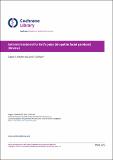Antiviral treatment for Bell’s palsy (Idiopathic facial paralysis)
Date
05/09/2019Metadata
Show full item recordAbstract
Background Corticosteroids are widely used in the treatment of idiopathic facial paralysis (Bell’s palsy), but the effectiveness of additional treatment with an antiviral agent is uncertain. This review was first published in 2001 and most recently updated in 2015. Since a significant benefit of corticosteroids for the early management of Bell’s palsy has been demonstrated, the main focus of this update, as in the previous version, was to determine the effect of adding antivirals to corticosteroid treatment. We undertook this update to integrate additional evidence and to better assess the robustness of findings, taking risk of bias fully into account. Objectives To assess the effects of antiviral treatments alone or in combination with any other therapy for Bell’s palsy. Search methods We searched the Cochrane Neuromuscular Specialised Register, CENTRAL, MEDLINE, Embase, and LILACS in July 2019. We reviewed the bibliographies of the identified trials and contacted trial authors to identify additional published or unpublished data. We searched clinical trials registries for ongoing studies. Selection criteria We considered randomised controlled trials (RCTs) or quasi-RCTs of antivirals with and without corticosteroids versus control therapies for the treatment of Bell’s palsy. We excluded trials that followed-up participants for less than three months. Data collection and analysis We independently assessed trials for relevance, eligibility, and risk of bias, using standard Cochrane procedures. We performed sensitivity analyses excluding trials at high or unclear risk of bias in at least five domains, and reported these data as the primary analyses. Main results Fourteen trials, including 2488 participants, met the inclusion criteria. Most were small, and most were at high or unclear risk of bias in multiple domains. We included four new studies at this update. Incomplete recovery A combination of antivirals and corticosteroids may have little or no effect on rates of incomplete recovery in people with Bell’s palsy compared to corticosteroids alone (risk ratio (RR) 0.81, 95% confidence interval (CI) 0.38 to 1.74; 3 trials, N = 766; random-effects; low-certainty evidence). We excluded 10 trials that were at high or unclear risk of bias in several domains from this analysis and limited all analyses to studies at lower risk of bias. Recovery rates were better in participants receiving corticosteroids alone than antivirals alone (RR 2.69, 95% CI 0.73 to 10.01; 2 trials, N = 667; random-effects), but the result was imprecise and allowed for the possibility of no effect. The rate of incomplete recovery was lower with antivirals plus corticosteroids than with placebo or no treatment (RR 0.56, 95% CI 0.42 to 0.76; 2 trials, N = 658; random-effects). Antivirals alone had no clear effect on incomplete recovery rates compared with placebo, but the result was imprecise (RR 1.10, 95% CI 0.87 to 1.40; 2 trials, N = 658; fixed-effect). For people with severe Bell’s palsy (House-Brackmann score of 5 and 6, or equivalent on other scales), we found that the combination of antivirals and corticosteroids had no clear effect on incomplete recovery at month six compared to corticosteroids alone, although the result was again imprecise (RR 0.82, 95% CI 0.57 to 1.17; 2 trials, N = 98; random-effects). Motor synkinesis or crocodile tears Antivirals plus corticosteroids reduced the proportion of participants who experienced these long-term sequelae from Bell’s palsy compared to placebo plus corticosteroids (RR 0.56, 95% CI 0.36 to 0.87; 2 trials, N = 469; fixed-effect; moderate-certainty evidence). Antivirals plus corticosteroids reduced long-term sequelae compared to placebo but there was no clear difference in this outcome with antivirals alone compared to placebo. Adverse events Adverse event data were available in four studies providing data on 1592 participants. None of the four comparisons showed clear differences in adverse events between treatment and comparison arms (very low-certainty evidence); for the comparison of antivirals plus corticosteroids and corticosteroids alone in studies at lower risk of bias, the RR was 1.17 (95% CI 0.81 to 1.69; 2 trials, N = 656; fixed-effect; very low-certainty evidence). Authors’ conclusions The combination of antivirals and corticosteroids may have little or no effect on rates of incomplete recovery in comparison to corticosteroids alone in Bell’s palsy of various degrees of severity, or in people with severe Bell’s palsy, but the results were very imprecise. Corticosteroids alone were probably more effective than antivirals alone and antivirals plus corticosteroids were more effective than placebo or no treatment. There was no clear benefit from antivirals alone over placebo. The combination of antivirals and corticosteroids probably reduced the late sequelae of Bell’s palsy compared with corticosteroids alone. Studies also showed fewer episodes of long-term sequelae in corticosteroid-treated participants than antiviral-treated participants. We found no clear difference in adverse events from the use of antivirals compared with either placebo or corticosteroids, but the evidence is too uncertain for us to draw conclusions. An adequately powered RCT in people with Bell’s palsy that compares different antiviral agents may be indicated.
Citation
Gagyor , I , Madhok , V B , Daly , F & Sullivan , F 2019 , ' Antiviral treatment for Bell’s palsy (Idiopathic facial paralysis) ' , Cochrane Database of Systematic Reviews , vol. 2019 , no. 9 , CD001869 , pp. 1-68 . https://doi.org/10.1002/14651858.CD001869.pub9
Publication
Cochrane Database of Systematic Reviews
Status
Peer reviewed
ISSN
1469-493XType
Journal item
Collections
Items in the St Andrews Research Repository are protected by copyright, with all rights reserved, unless otherwise indicated.

